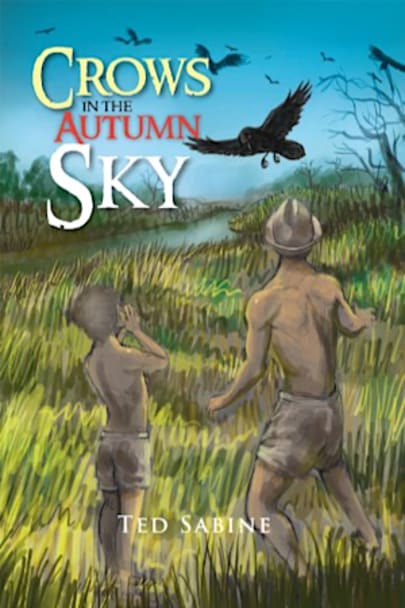Crows In The Autumn Sky is loosely based on my childhood experiences in the small town of Zion, Illinois during WWII. It’s main focus is the love affair between me and Sam, a fast-talking, tail-pulling, ear-tweaking, let-me-sell-you-a-used-car pet crow. For one glorious summer and fall Sam and I hunted frogs, bullheads and crayfish in the local ditches and ponds. We went on bike rides with Sam … perched like a noise hood ornament on my Chicago White Sox baseball cap. With his sharp eyes and nimble beak, Sam collected a treasure trove of ear rings, watches, roller skate keys, scarves and caps. A sociable bird, he considered me and most everyone in the neighborhood to be members of his flock, warning us of perceived dangers that hove into view. Animals and people who shouted and threw rocks. They could be teased and cussed at from the safety of a telephone line or a tree. But a danger Sam should have learned about from a mother crow, and did not learn from me, was the danger that stalked into our lives one crisp, November morn.
more



This fact/ fiction story takes us on a nostalgic voyage back to small town America during World war ll. It is written from the point of view\ of Teddy Sabine,a ten-year old kid who climbs to the top of a big tree and swipes an unfledged baby crow from it’s nest.. What follows is a sort of Jack-the-Bean-Stalk experience.
With the baby crow clinging to his Chicago White Sox T-shirt, trying to eat his ear and pooping all over his shoulder, the young thief slides down the tree with rough bark pulling his T-shirt up over his belly and chest .
” SAM-SAM-SAM” the mother crow shrieks. By the time Teddy thumps to earth he has, not a golden goose, but a gawky, poop-stained baby crow. And it’s name is Sam . Confined at first to a shoe box stuffed with toilet paper, Sam is allowed to hop, flop, flutter, then fly free in the Sabine yard, then through out the neighbor hood. Crows are sociable birds, gifted with brain power that has just partially been discovered. As he matures, Sam develops into a picaresque hero, bringing outrage and laughter to the neighborhood.He terrorized cats, stole anything shiny : watches, roller skate keys, tin foil, and even a pair of pajama bottoms with metal clips. From there he graduated to opening mailboxes and switching letters from one box to the next.
The book winds up being about more than a pet crow. Sam’s interactions with humans reveals their qualities , good and bad.
Teddy’s mother roller skates back and forth in the kitchen and feeds Sam while tending to Carson John who blows cereal and baby food all over his high chair as well as the kitchen floor. The father, Theodore, owns Sabine Fine Foods, a meat market and grocery store that served the city of Zion. Illinois for the better part of two generations. Theodore assumes prominence when he and Teddy hike along Dead River in the final scene of the novel. There they see some huge carp stranded
in a muddy off shoot of Dead River. Pretending the carp are “fair maidens” under an evil spell, father and son slop through mud and water and drag the “Fair Maiden” carp back to the main river. Each fair maiden must be kissed on its fishy, blubbery lips before its release. A messy task, but in light of previous events its the most important task for the day. After their Quixotic task is complete they see a flock of crows playing “crow tag” among some jack pines not too far away.
CAAAAWWW, CAAAWWW, CAWWWWW. The boy and his dad call out to the crows.
And the crows answer as the flock beats its way toward the river, then form a noisy circle overhead.
It is here the story ends. “Dad and I answer them. . . .Cawing so loud—-it seemed like our lungs and maybe the rest of our insides might bust wide open as we flung our voices and maybe even a part of our souls higher and higher.
Into the clear, autumn sky.